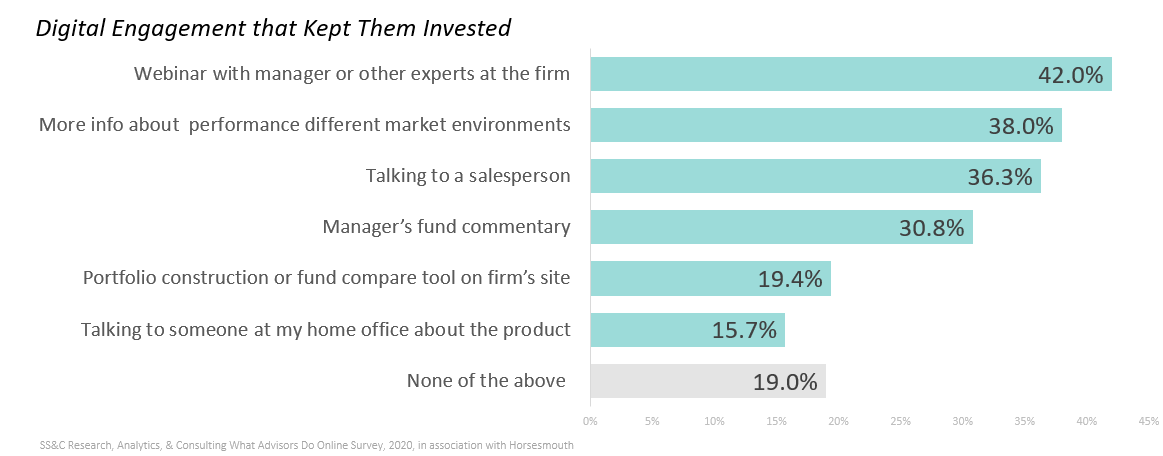Like most industries, strategies to keep customers from leaving take a back seat to driving new sales. But reducing redemptions can be more cost-effective and profitable than finding new clients. In fact, one asset manager that we work with has found that, among similarly priced products, one with a 21% higher retention rate translates to 33% higher revenue.
To dive into asset retention further, we asked advisors about the impact that digital engagement has on retention in our annual "What Advisors Do Online" survey. We found that 95% of advisors considered moving clients out of a product in the past year, but the majority decided against redemption after engaging with a firm digitally in some way.

Two in five advisors said they decided against redemption after attending a webinar or webcast with the portfolio manager, or other investment experts at the firm. When offered live, this format delivers timely insight and a greater sense of transparency, since advisors are hearing directly from the manager in real-time and can ask the manager questions. Vocal and visual cues enhance understanding and confidence in both the manager and the message. So hosting a webcast is a good strategy anytime there are performance issues or other changes that could spark concerns about a product.
On the other hand, reviewing the portfolio manager’s commentary—which is far more accessible than waiting for a webcast or call to be scheduled—ranked fourth. Yes, it’s still communicating the portfolio manager’s thoughts, but in a much more filtered way. Pressures from compliance departments to standardize fund commentary, as well as the adoption of AI-assisted production, are making product commentary more generic and less insightful. And lag time can be an issue, especially if firms are only publishing the commentary quarterly.
The second most important factor: 38% of advisors said they kept clients in the product after learning more about its expected performance in different market environments. Advisors know that every investment product has favorable and unfavorable market environments. So learning that a particular performance rout is due to market tailwinds the portfolio manager expected—instead of poor decisions or a deviation from the investment process—is reassuring, and will convince many advisors to stay the course.
While this factor is more about the message than the medium, its importance shows that firms must make sure these expectations are prioritized and communicated in a number of digital messages when performance is an issue.
Firms should also be clearly communicating these expectations from the start, so advisors better know what to expect and how a product may work within a client’s portfolio. Yet, only 3.7% of the 54 firms we evaluated for our last Digital Engagement Leaders study explained how a product will perform in various markets or showed market cycle performance on its product profile.
Surprisingly, a portfolio construction/fund compare tool on the asset manager’s website prompted one in five advisors to stay invested in a product in the past year. These tools are usually added to the website to get advisors to buy a product—not keep them from redeeming it. But good versions of these tools can do exactly that by showing the bigger picture of the role a product is playing within a portfolio, highlighting other important benefits of the fund, such as risk management, or calling attention to traits that still make the fund more attractive than a competitor.
The one potentially non-digital top-five factor, talking to a salesperson, ranked third. But this was far more effective (55.8%) for advisors with broker-dealer employee business models (largely advisors with the wirehouses and some regional broker-dealers). The number of hybrid RIA business models who chose it was about half, and it was even lower with independent RIAs.
Bottom line, when advisors’ concerns about a product start to mount, digital can deliver the timely information and insights that assuage their concerns, enhance confidence in the managers and prevent them from redeeming investments in a fund.
These results are a good start for better understanding how and what asset managers can do to better leverage digital for this purpose, and we plan to build on them in this year’s version of the survey. In the meantime, more results of this year’s research are published in Digital That Makes a Difference -- Advancing the Decision Journey Online.
Written by Tracy Needham
Sr. Business Research Analyst, Research, Analytics and Consulting






